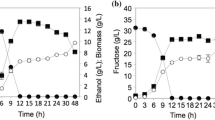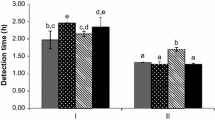Abstract
We have evaluated the induction of the flocculent phenotype of Kloeckera apiculata by glucose mc1 and propose a pathway involved in carbohydrate flocculation induction. Pulses of glucose were given to cells growing in glucose-poor medium (2 g l−1) and the flocculation percentage was measured. To elucidate the mechanism involved in flocculation induction, cycloheximide was injected into the cultures 120 min before the glucose pulse. 2,4-Dinitrophenol or cAMP was added to the media instead, or simultaneously with glucose, while a protein kinase A (PKA) inhibitor was added 30 min before the glucose pulse. With 20 and 50 g l−1 glucose pulse, the yeast flocculation percentage arises to 55 and 65%, respectively. The quantity of proteins and the reflocculating capacity of a lectinic protein extract from the yeast cell wall increase as the concentration of glucose pulse was higher. Cycloheximide prevented the glucose-induced flocculation, while cAMP or 2,4-dinitrophenol increased it 4- and 5-fold, respectively. PKA inhibitor completely prevented the glucose induction flocculation. The flocculent phenotype of K. apiculata mc1 was induced by glucose and the mechanism seems to imply de novo protein (lectin) synthesis via the PKA transduction pathway. This work contributes to the elucidation of the mechanism involved in flocculation induction by glucose of a non-Saccharomyces wine yeast, K. apiculata, which has not been reported. The induction of flocculation by glucose could be a biotechnological tool for the early removal of the indigenous microorganisms from the grape must before the inoculation of a selected starter strain to conduct the alcohol fermentation.




Similar content being viewed by others
References
Al-Mahmood C, Colin S, Bonaly R (1991) Kluyveromyces bulgaricus yeast lectins: isolation of two galactose specific lectins forms from yeast cell wall. J Biol Chem 266:20882–20887
Amri MA, Bonaly R, Duteurtre B, Moll M (1979) Growth and flocculation of two Saccharomyces uvarum strain. Eur J Appl Microbiol Biotechnol 7:227–234
Bendiak DS (1994) Quantification of the Helm’s flocculation test. J Am Soc Brew Chem 52:120–122
Caspani G, Tortora P, Hanozet GM, Guerritore A (1985) Glucose-stimulated cAMP increase may be mediated by intracellular acidification in Saccharomyces cerevisiae. FEBS Lett 186:75–79
Crauwels M, Donaton MCV, Pernambuca MB, Winderickx J, de Winde JH, Thevelein JM (1997) The Sch9 protein kinase in the yeast Saccharomyces cerevisiae control cAPK activity and is required for nitrogen activation of the fermentable-growth-medium induced (FMG)-pathway. Microbiology 143:2627–2637
El-Behhari M, Ngondi Ekomé J, Pucci B, Coulon J, Bonaly R (1998) Comparative extraction procedures for a galactose specific lectin involved in flocculation of Kluyveromyces lactis strains. Appl Microbiol Biotechnol 49:16–23
Farías ME, Manca de Nadra MC (2003) Flocculation and cell surface characterization of Kloeckera apiculata form wine. J Appl Microbiol 95:457–462
Fernandes PA, Sousa M, Morales-Ferreira P (1993) Flocculation of Kluyveromyces marxianus is induced by temperature upshift. Yeast 9:859–869
Gagiano M, Bauer FF, Pretorius IS (2002) The sensing of nutritional status and the relationship to filamentous growth in Saccharomyces cerevisiae. FEMS Yeast Res 2:433–470
Gagiano M, Bester M, van Dyk D, Franken J, Bauer FF, Pretorius IS (2003) Mss11p is a transcription factor regulating pseudohyphal differentiation, invasive growth and starch metabolism in Saccharomyces cerevisiae in response to nutrient availability. Mol Microbiol 47:119–134
Géhin G, Bonaly R, Coulon J (2001) The role of glucose in the Kluyveromyces bulgaricus flocculation phenomenon: transduction by cAMP-dependent protein kinase pathway? FEMS Microbiol Lett 203:229–233
Helm E, Nohr B, Thorne RSW (1953) The measurement of yeast flocculence and its significance in brewing. Wallerstein Lab Communs 16:315–355
Javadekar VS, Sivaraman H, Sainkar R, Khan MI (2000) A mannose-binding protein from the cell surface of flocculent Saccharomyces cereivsiae (NCIM 3528): its role in flocculation. Yeast 16:99–110
Jin YL, Speers RA (1999) Flocculation of Saccharomyces cerevisiae. Food Res Intern 31:421–440
Jin YL, Speers RA (2000) Effect of environmental conditions on the flocculation of Saccharomyces cerevisiae. J Am Soc Brew Chem 58:108–116
Johnson BF, Walker T, Calleja GB, Seligy VL (1988) Sexual co-flocculation and asexual self-flocculation in budding and fission yeast: experimental establishment of a fundamental difference. Can J Microbiol 34:1105–1107
Kim TS, Kim HY, Yoon JH, Kang HS (2004) Recruitment of the Swi/Snf complex by Ste12-Tec1 promotes Flo8-Mss11-mediated activation of STA1 expression. Mol Cell Biol 24:9542–9556
Kraakman L, Lemaire K, Ma P, Teunissen WRH, Donaton MCV, van Dijck P, Winderickx J, de Winde J, Thevelein JM (1999) A Saccharomyces cerevisiae G-protein coupled receptor Gpr1, is specifically required for glucose activation of the cAMP pathway during transition to growth on glucose. Mol Microbiol 32:1002–1012
Madhani H, Fink G (1997) Combinatorial control required for the specificity of yeast MAPK signaling. Science 275:1314–1317
Miki BLA, Poon NH, James AP, Seligy VL (1982) Possible mechanism for flocculation interactions governed by gene FLO1 in Saccharomyces cerevisiae. J Bacteriol 50:878–889
Purwin C, Nicolay K, Scheffers WA, Holzer H (1986) Mechanism of control of adenylate cyclase activity in yeast by fermentable sugars and carbonyl cyanide m-chlorophenylhydrazone. J Biol Chem 261:8744–8749
Romano P, Fiore C, Paraggio M, Caruso M, Capece A (2003) Function of yeast species and strains in wine flavour. Int J Food Microbiol 86:169–180
Rupp S, Summers E, Lo HJ, Madhani H, Fink G (1999) MAP kinase and cAMP filamentation signaling pathways converge on the unusually large promoter of the yeast FLO11 gene. EMBO J 18:1257–1269
Sampermans S, Mortier J, Soares EV (2005) Flocculation onset in Saccharomyces cerevisiae: the role of nutrients. J Appl Microbiol 98:525–531
Schwartz MA, Madhani HD (2004) Principles of MAP kinase signaling specificity in Saccharomyces cerevisiae. Annu Rev Genet 38:725–748
Soares EV, Texeira JA, Mota M (1994) Effect of cultural and nutritional conditions on the control of flocculation expression in Saccharomyces cerevisiae. Can J Microbiol 40:851–857
Soares EV, Mota M (1996) Flocculation onset, growth phase, and genealogical age in Saccharomyces cerevisiae. Can J Microbiol 42:539–547
Soares EV, Vroman A (2003) Effect of different starvation conditions on the flocculation of Saccharomyces cerevisiae. J Appl Microbiol 95:325–330
Stewart GG (1975) Yeast flocculation. Practical implications and experimental findings. Brew Dig 50:42–62
Stratford M (1992) Lectin-mediated aggregation of yeasts–yeast flocculation. Biotechnol Genet Eng Rev 10:283–341
Stratford M (1994) Genetic aspects of yeast flocculation: in particular, the role of FLO genes in the flocculation of Saccharomyces cerevisiae. Colloids Surf B Biointerfaces 2:151–158
Stratford M, Carter AT (1993) Yeast flocculation: lectin synthesis and activation. Yeast 9:371–378
Straver MH, Smit G, Kijne J W (1994) Purification and partial characterization of a flocculin from brewer’s yeast. Appl Environ Microbiol 60:2754–2758
Teunissen AWRH, Steensma HY (1995) Review: the dominant flocculation genes of Saccharomyces cerevisiae constitute a new subtelomeric gene family. Yeast 11:1001–1013
Teunissen AWRH, Van Der Berg J, Steensma HY (1995) Transcriptional regulation of flocculation genes in Saccharomyces cerevisiae. Yeast 11:435–446
Thevelein JM, Cauwenberg L, Colombo S, de Winde JH, Donation M, Dumortier F, Kraakman L, Lemaire K, Ma P, Nauwealaers D, Rolland F, Teunissen A, van Dijck P, Versele M, Wera S, Winderickx J (2000) Nutrient-induced signal transduction through the protein kinase A pathway and its role in the control of metabolism, stress resistance, and growth in yeast. Enzyme Microb Technol 26:819–825
van Dyk D, Pretorius IS, Bauer FF (2005) Mss11p is a central element of the regulatory network that controls FLO11 expression and invasive growth in Saccharomyces cerevisiae. Genetics 169:91–106
Verstrepen KJ, Iserentant D, Malcorps P, Derdelinckx G, van Dijck P, Winderickx J, Pretorius IS, Thevelein JM, Delvaux FR (2004) Glucose and sucrose: hazardous fast-food for industrial yeast? Trends Biotechnol 22:531–537
Verstrepen KJ, Klis FM (2006) Flocculation, adhesion and biofilm formation in yeasts. Mol Microbiol 60:5–15
Vyas VK, Kuchin S, Berkey CD, Carlson M (2003) Snf1 kinases with different beta-subunit isoforms play distinct roles in regulating haploid invasive growth. Mol Cell Biol 23:1341–1348
Winderickx J, Holsbeeks I, Lagatie O, Giots F, Thevelein J, de Winde H (2003) From feast to famine: adaptation to nutrient availability in yeast. In: Hohmann S, Mager PWH (eds) Topics in current genetics, vol. 1: yeast stress responses. Springer, Berlin, pp 305–386
Yaguchi S, Mitsui K, Iba H, Tsurugi K (2000) Phosphorylation of the GTS1 gene product of the yeast Saccharomyces cerevisiae and its effect on heat tolerance and flocculation. FEMS Microbiol Lett 187:179–189
Acknowledgments
This work was supported by grants from Banco Río, Consejo Nacional de Investigaciones Científicas y Técnicas (CONICET) and Consejo de Investigaciones de la Universidad Nacional de Tucumán (CIUNT), Argentina.
Author information
Authors and Affiliations
Corresponding author
Rights and permissions
About this article
Cite this article
Sosa, O.A., de Nadra, M.C.M. & Farías, M.E. Modification by glucose of the flocculent phenotype of a Kloeckera apiculata wine strain. J Ind Microbiol Biotechnol 35, 851–857 (2008). https://doi.org/10.1007/s10295-008-0357-2
Received:
Accepted:
Published:
Issue Date:
DOI: https://doi.org/10.1007/s10295-008-0357-2




